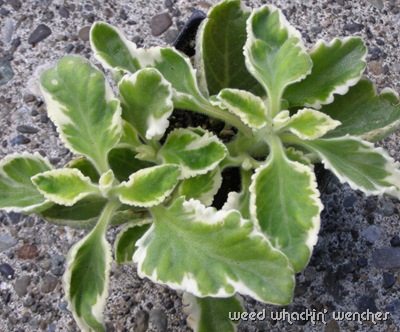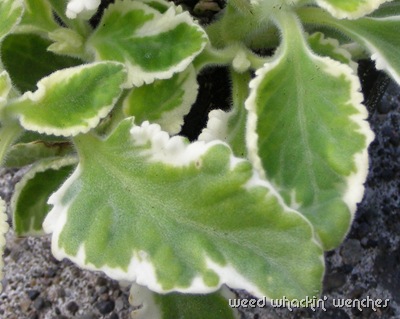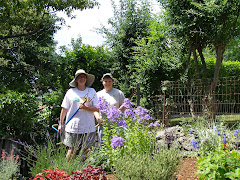If you were to ask me what my favorite day of the week is, I would reply without hesitation THURSDAYS. Thursdays make me smile and dance with glee. I spend the day full of A-N-T-I-C-I-P-A-T-I-O-N because Thursday is the day when new plants find their way to our garden as Wing Nut often does a little shopping before heading home at the end of her work week.
This week was "hyper" special because Cuban Oregano came to live with us. It has always been a treasure hunt when we settle in a new place to find him. The nice, but often clueless, nursery people always try to sell me on Greek, Italian or, GASP, Puerto Rican varieties. Here in the PNW I've been looking to cross paths with Cuban Oregano for 4 years now. When in NE, it took me 2 years to find him. So far, with enough patience and persistence--and some educating of the nursery staff--I have always been able to find him.
Isn't he spectacular? The Greek and Italian varieties are so insubstantial when compared to this plant. The leaves and stems of Cuban oregano are thick and fleshy and hairy. When you rub them with your fingers, the aroma of the leaves is out of this world.
This is a very important culinary herb in the Caribbean. In Cuban cooking, it is used to flavor black beans and roasted pork, to infuse oils or vinegars, to garnish salads or drinks. It also has medicinal uses. In Cuba the curanderos (healers) and yerberos (herbalists) use this plant to help with digestive ailments, bronchitis and rheumatoid arthritis.
If you ask any Cubans they will swear that this is the verdadero or real oregano. The first irony is that it is not a true oregano. This is plectranthus amboinicus, a member of the mint family and a relative of the garden coleus. The second irony is that it is not native to Cuba but rather to southeast Asia. Some sources say Africa but I've found numerous references to this plant in Vietnamese herb/cooking books. In Cuba it is called "orégano de la tierra" or "orégano francés," the latter pointing to Haiti as a point of introduction. It most likely was introduced in Haiti during the French colonial period. Adding to the difficulty of tracking down this plant are its numerous other names--Spanish thyme, French thyme, Mexican mint, Indian mint, soup mint, Indian borage, country borage, and oreille (French for ear).
Cuban oregano is hardy only to zone 10 so I have always grown it as an annual. It continues to look its best in the hottest part of summer even when kept in full sun. I've read that it can grow to 2' though I've never had one that grew that much. Plucking leaves and stems for culinary use helps the plant maintain a nice compact bushy shape.
I'd love to hear from anyone who has grown this plant. Do you grow it as an ornamental or as an herb and under what conditions? If grown as an herb, how do you use it?



























































24 comments:
This oregano looks impressive.I've never grown this plant, but will be on the lookout now! Thanks for sharing.
I've never heard of Cuban Oregano. I enjoed learning about it. I'd like to try it sometime.
It's a beautiful plant, with much to recommend it. I've never seen it around here, but you can be sure I'll be keeping my eyes open for it after reading your post! Congratulations on finding it. That's determination.
Hmm, I wonder if it could be over wintered? I haven't had the opportunity to grow my own herbs yet as Cheesehead is very picky when it comes to his eats and so far I've been stuck with buying canned pre-spiced pizza sauces and such.
I grew it a couple of years ago in a container. It did not overwinter in the greenhouse. Seems like 40 degrees was more than it could stand. Funny, Thursday is my favorite day too. It is the first day of my husband's "weekend."
I added Cuban Oregano to my herb garden this spring (i garden in zone 9b or 10 depending on who you believe). The garden center employee highly recommended it - says it has ten times the flavor of other oreganos. I'm still letting mine grow but it looks to be hearty enough for me to start plucking leaves for tastey dishes.
This is known as "Spanish thyme" in Trinidad and "stingy thyme" in the Eastern Caribbean. It is an essential herb there in seasoning meat and fish. I use the young leaves like sage and also to add to vegetable stews. I do know in some islands a tea is brewed for various medicinal purposes but am not too sure what.
hey what took you guys so long?!? mark brought me home some last week. I've been meaning to email you to ask you about it, and what luck, I go to your blog, and what do I find but an article on my oregano. perhaps you could recommend some recipes?
the rest of the monsters say hi.
Geez, dollins, I am stupefied! I grow seven kinds of plectranthus in containers here in scenic PA, including this one--on the deck during the season, in the greenhouse over winter--but had no idea they were actually edible! I love the colors and velvety textures and heavenly fragrance. You all MUST head over to the Well-Sweep Herb Farm website and see if they're still selling their green-and-gold variegated form, 'Well-Sweep Wedgewood'. It and the one you're growing are the loveliest of all!
Wow, I never knew plectranthus was edible either! Very informative. I grow several different kinds in my various containers but not this one. I'll have to check into it. Anything that looks good and serves a dual purpose is always a winner.
Wow, this is a truly outstanding post...amazing detail...I would love to republish, with your permission (and credit) on my new blog www.portlandfoodie.com
And, I have grown Cuban oregano as an ornamental, I didn't even realize I could eat it...somehow the hairy leaves scared me...I will just leave it at that...:)
An unusual and beautiful plant. Since it is in the Lamiaceae or mint family like true oregano, it probably shares some of the same medicinal properties. These include being antiviral, antibacterial, antifungal, antiparasitic (no wonder it has been used to season pork dishes), anti-inflammatory, and acting as a stimulant to the immune system. Aren't plants amazing?
i have been growing plectranthus amboinicus var. for about ten years indoors and out. it hovers around the nine to ten inch tall range, but with special attention (verging on hydroponic -- river sand and manure tea) it can get leaves over four inches in diameter, and very stout long stems that shoot up past two feet even in a windowsill container. this spring i also found a small alternate-leaved sport developed from a damaged cutting that i'm hoping to propagate permanently. truly my favorite plant. well worth the repeated quests. mazel tov!
I discovered this plant while visiting Trinidad a few years back. The best way to use it is to combine it with any other fresh herbs you have on hand (it doesn't matter what you use, it's always good), chop them up together, add just a touch of viegar, and keep it handy in the refrigerator. This concoction is called "seasoning", you can add as much or as little as you like to sauces, stews, soups, even scrambled eggs. The sky is the limit. Have fun with your cooking.
I got a cutting of this plant in a plant cuttings trade last summer and have had it growing in my dining room window sill facing east and getting only a little morning sun. From what I'm reading here, I think I'd better move it to a sunnier location to give it better light as it has smallish leaves and has a creeping nature to its growth. Its smell is truly intoxicating and while I haven't cooked with it, many of my friends have taken cuttings. So tonight I decided to find out what I can use it for in cooking. I'm so glad I found this posting, its just great! Thank you.
I love this plant for many reasons. First it grows very fast, second it attracts all the garden pests, third it is brutally resistant to all garden pests(best pesticide I've ever seen), fourth it is an amazing spice, fifth it is amazing at increasing blood flow and calming the stomach, sixth not only is it gorgeous in a garden but is an incredible house plant, eighth is smells great, ninth it is simply needing our attention. Tasty, useful, and begging for our attention, this Vietnamese plant deserves a second look.
Lucky me to have run into this plant at a Farmers Market...it's pretty leaves attracted me and then it's aroma captured me..I want to grow more and more of it.. I want to grow it inside and outside..to make sure I have it...:o)
Just discovered Cuban Oregano at a local nursery this year and I am smitten. I've used it so far in Texas Caviar. I was out of cilantro and it's not the same flavor at all, but it has a distinct, heady, captivating fragrance and taste- next time I will use even more! It roots at the drop of a hat and grows with very little sun on my back deck. I hope to always have this plant around and since it doesn't need blazing sun all day long, I suspect it will overwinter pretty well indoors in a bright window.
I have been growing Cuban Oregano indoors in Canada for over 2 years now... after finding it at a nursery and bringing it home because I was promised how easy it is to care for! It has been really easy and does need plenty of plucking or else it will get long and straggly. Beautiful plant though!
I've been growing this for about 10 years & shared it with many others. Occasionally, I've lost it and have had to order it. The source that seems to have the real thing is http://www.mountainvalleygrowers.com/. I've found that this plectranthus is a true oregano only if it develops (when grown in direct sunlight) a hot pink on the stems and into the green and white leaves. The plecs that don't develop the pink color have a lovely oregano fragrance, but have a very bitter and harsh flavor. The pink one isn't harsh. This plant is a plectranthus that was re-catagorized as a true oregano because it contains true oregano oil. I've just received a new set of plants from Mt Valley, so they haven't developed the pink color yet. I'll post a pic when they do.
the botanical name is Plectranthus Amboinicus
This summer I got a cutting that my mother said was "Cuban basil." After doing a little cursory research, I quickly realized it was NOT Cuban basil, and finally discovered that it is a Jamaican variegation of Cuban oregano, still fuzzy and succulent but with more pronounced ridges on the leaf edges. I have chopped it up with rosemary and rubbed it on ribeye, and definitely plan to use it in stuffing. TASTY.
In Anguilla we call this Stingy Thyme and people throw it in the pot to season a stew. It is also used for tea.
Grows wild all over the island I have a big patch in my garden and give off a wonderful scent if you spray it with a water hose.
I grew this fuzzy scented plant indoors for over 10 years before finding out it was an annual herb. I now plant some outside every spring and find that the more sun the plant gets, the more errect the veins on the underside of the leaves get. I've used it in a few dishes and look forward to trying it fried once I find all the Indian ingredients listed in a recipe I just found on line.
--I keep my indoor plant next to my back door and everytime I go in or out I brush against it just to smell it....Love it!
Post a Comment